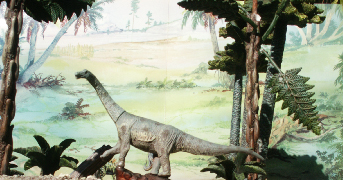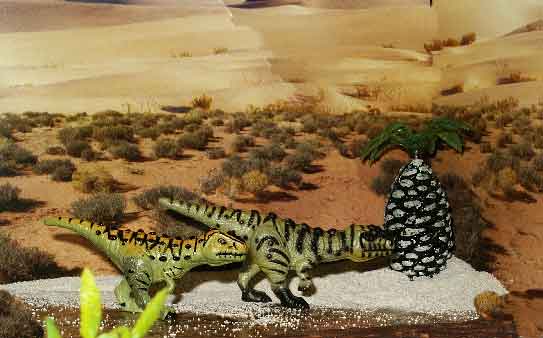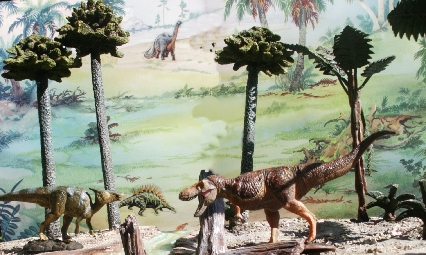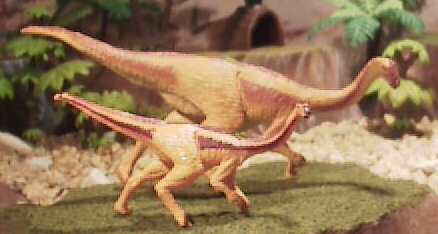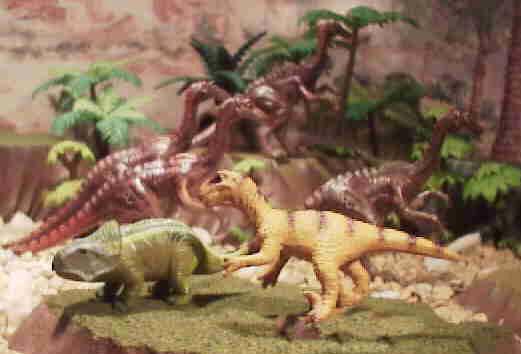Late Cretaceous Asia
from the Dinosaur Collector Page 1
More Diorama Pages Asian Diorama Pages
Asia had a wide range of ankylosaurs, hadrosaurs and tyrannosaurs related to forms found in North America. This could mean that they moved between Asia and America, via the still existing land bridge across what is now the Bering Strait between Siberia and Alaska. Like North American ornithiscians, the duckbills and armored ankylosaurs are the main plant-eating dinosaurs and tyrannsaurids, ornithiomimids and raptors are the major meat-eating dinosaurs. Some sauropods are still present, and the fauna is distinct from the Gondwanaland fauna in Africa and South America.
Updated 122208 proof 020606 rjk
|
Opisthocoelicaudia is a sauropod from the Late Cretaceous Asia. It may be the same as Nemegtosaurus, another sauropod found in the same area and time. As no skull has been identified we may have another Brontosaurus where the lack of a skull gives us an invalid name . Asian sauropods don't seem to make the trip to North America. |
|
Alioramus is a rare tyrannosaurid known from limited material. Could be young Tarbosaurus. It characterized by the row of five bony crests along the top of its snout, and also has more teeth than any other tyrannosaurid. Size is difficult to estimate without a confirmed adult fossil. |
|
|
|
|
|
UHA Collector Club Opisthocoelicaudia. |
|
Disney World Alioramus |
|
Saurolophus was a hadrosaur found both in Asia and North America. Saurolophus had a 5-inch bony spike extending up from its forehead, and there is speculation that it was attached to a flap of skin that covered the nostrils and could be blown up for displays and noise-making. Saurolophus was about 30-40 feet long, with hundreds of closely packed cheek teeth; characteristic of the hadrosaur family. Caudipteryx was a small, feathered theropod. It has enlarged, bird-like feathers on its hands and tail tip; more than the Jurassic Sinosauropteryx. The feathers may have played a role in courtship, but they could also have enhanced mobility and stability in a two-legged runner. |
|
The Tarbosaurus and Saurolophus are another cosmopolitan pair from the Asian Cretaceous. Both have close ties to North American fossils. Tarbosaurus may just be a slender variant of the North American Tyrannosaurus while Saurolophus has been on both continents. Conventionally this is seen to show that the close relationship of the fauna was a result of migrations from Asia to North America in the Late Cretaceous. |
|
|
|
|
|
Caudipteryx from the Yowie series. Saurolophus from the Tyco Dino Riders. The Velociraptor is from the Japanese Kabaya Dino World series. |
|
UHA Collectors Club Saurolophus and Tarbosaurus. |
Segnosaurs are strange therapods found in China (and now in North America, where they seem to have originated). Suggested to be vegetarians and resembling the extinct prosauropods of the early Mesozoic, they may have filled the same niche as the Giant Sloth. Therizinosaurus cheloniformis (Turtle-form Scythe-Lizard) is estimated to be around 36 feet long, though so far only the claws are really known. It was first thought to be a giant turtle, later said to a surviving prosauropod, but now seen as a true theropod. This uncommon animal is also found in North America. It may have been a browser; using the long claws to pull down tree branches like the grant sloth. What segnosaurs ate and how they lived is still unknown; ideas that they were fish eaters or fed on termites have been suggested, but don't seem very practical. Reconstructions are usually based on fossils of a several relegated forms like Alxasaurus, Erlikosaurus and Segnosaurus, as finds are rare and incomplete. Recent finds in China indicate they were feathered.
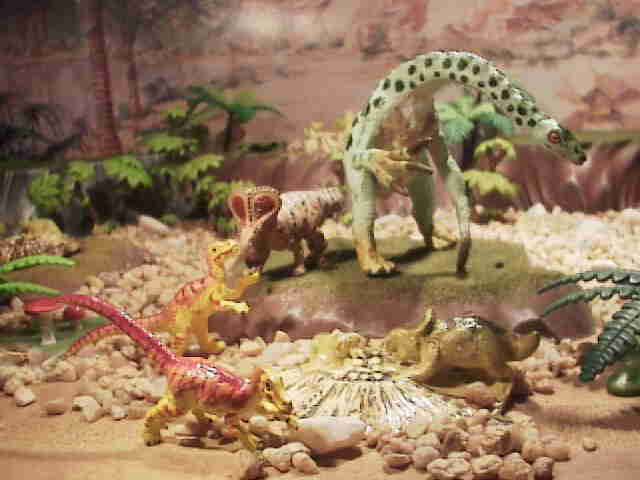
Safari Protoceratops and Velociraptor from the Habitat series now called Mini Carnegie, the Carnegie Safari discontinued Protoceratops with nest, and center is the green Safari Therizinosaurus from the Dinosaurs of China series, done by Eli Kish.
Shantungosaurus (Shandong Lizard), at 45
feet or more, reached the size of a sauropod. This largest of the flat
headed hardrosaurs resembled Edmontosaurus, from North America.

Shangtungosaurus, from Series 4 Kaiyodo Choco Eggs.
Saichania was an ankylosaurid known
from its back and belly armor. These armored dinosaurs are well
represented in Asia, and may have evolved there before spreading to North
America.

The Schleich Saichania is a representative of the Asian ankylosaurids. It is the counterpart to the more common North American Euoplocephalus and Ankylosaurus figures. The Protoceratops and Velociraptor are from the BETTA products fun packs, and are similar to the habitat series in style.
|
The earliest Ornithimimids
are known from China in the Late Triassic if Shuvosaurus is
discounted. They are well known from North America, and fragmentary
finds in Australia and elsewhere suggest that the group may represent
convergent evolution of a local species. |
|
Gallimimus had a long snout with a flat tipped beak and spade like hands. The hands appear to lack the flexibility for grasping |
|
|
|
|
|
The Battat
Boston Museum collection Gallimimus comes in two
sizes. Gallimimus was made famous by Jurassic Park and
has replaced Struthiomimus as the most popular of the
ornithimimid figure in dinosaur lines. It was the largest known of
these fast ostrich like animals. |
|
Bullyland Velociraptor from their small series, K&M Protoceratops, and a flock of JP Gallimimus. |
.
Click on the Site A icon to the right for Dioramas organized by period or by manufacturer.
